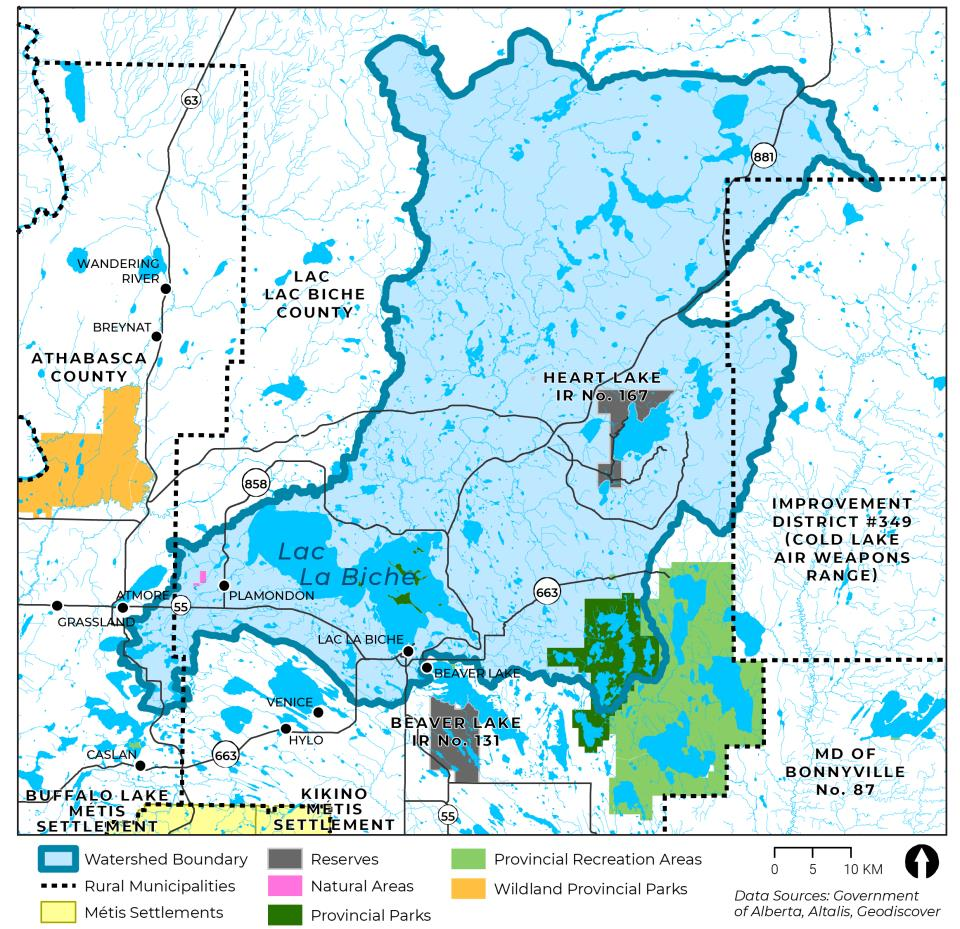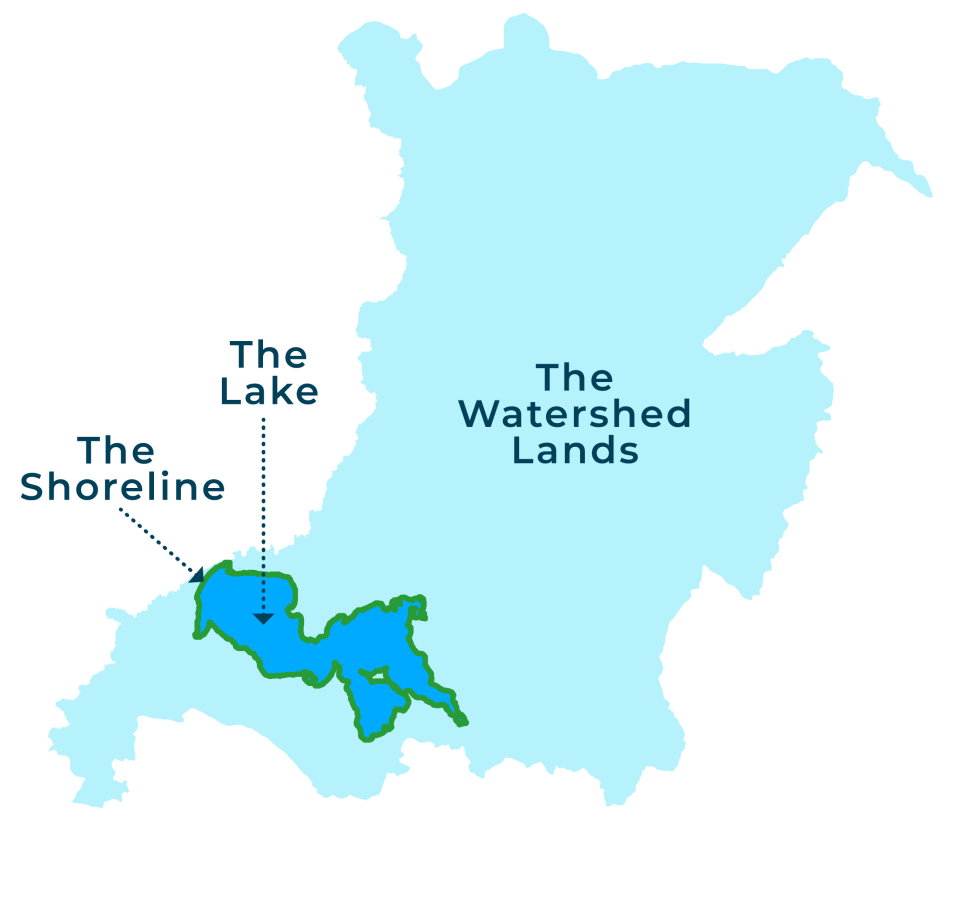About the watershed
A watershed is an area of land, bounded by topographic features, where precipitation, groundwater, and bodies of water such as streams, rivers, marshes or lakes drain into a larger body of water. A watershed is made up of a number of sub-watersheds.
The Lac La Biche Watershed is approximately 4,370 square kilometres and is primarily located within Lac La Biche County. The Lac La Biche Watershed drains into Lac La Biche, which then drains into the La Biche River. The La Biche River then flows into the Athabasca River.

What is a Watershed Management Plan?
The 2021 WMP is an adaptable, comprehensive, evidence-based plan that includes action plans to help protect and improve water quality and keep the lake and watershed healthy, while balancing environmental, economic and community needs within the watershed. The 2021 WMP is intended to serve as a guiding document for decision-makers within the watershed including:
- Government of Alberta
- Municipalities
- Local communities, organizations, and residents
The 2021 WMP includes:
- Evaluation of historical and current conditions of the watershed
- Identification of resources and concerns
- Identification of objectives, recommendations, and actions for the long-term management of land and water resources
- Implementation and monitoring plans
A Steering Committee was established to help guide the preparation of the updated WMP. The Steering Committee included representatives from Lac La Biche County Council and Administration, Alberta Environment & Parks, Indigenous communities, Watershed Planning and Advisory Councils (WPACs), Healthy Waters Lac La Biche, local and regional non-governmental organizations (NGOs), local industry (forestry, oil and gas), and local associations and organizations.
The purpose of the Steering Committee was to:
- Develop Terms of Reference for the preparation of the 2020-2021 WMP
- Identify and compile all technical and scientific information that may be required for the 2020-2021 WMP
- Adopt a structured decision-making process that will allow partners and stakeholders with diverse values and interests to effectively update the WMP
- Organize public engagement to share information and receive input from interested partners, stakeholders, and watershed area residents
- Prepare an updated, draft WMP for:
- Review by Alberta Environment & Parks
- Consideration by Lac La Biche County Council

WMP Implementation Committee
The purpose of the Implementation Committee is to implement the recommendations set out in the Lac La Biche Watershed Management Plan. The plan was adopted by Lac La Biche County Council on May 25, 2021.
The Implementation Committee will oversee the administration of the WMP, support continued relationship-building, communication, collaboration, grassroots education, monitoring and annual reporting on the implementation and effectiveness of the plan. Successful implementation of the LLBWMP will support the vision “to protect and restore the lake and watershed by leading in knowledge sharing, research, policy, and action.”
The following specific tasks have been identified as necessary to implement the Lac La Biche Watershed Management Plan:
- Review the Terms of Reference for the Lac La Biche Watershed Management Plan Implementation Committee;
- Maintain membership of the Implementation Committee to ensure full representation of all key partners and stakeholders;
- Review the reporting template, which includes 89 recommended action items;
- Determine the type, roles, timeframe, success measures, priority, and status for every recommended action item within the reporting template;
- Identify and compile all technical and scientific information that may be required to complete the reporting template and the implementation of the Lac La Biche Watershed Management Plan;
- Provide existing technical information and data relevant to the implementation process;
- Adopt a structured decision-making process that will allow partners and stakeholders, with a diverse array of values and interests, to effectively and constructively recommend implementation strategies for the Watershed Management Plan;
- Support implementation of the Watershed Management Plan by carrying out and completing all recommended action items, as determined by the Implementation Committee;
- Submit a draft of the reporting template from the Lac La Biche Watershed Management Plan to Lac La Biche County for Council’s consideration.
Provide recommendations for any updates to the Lac La Biche Watershed Management Plan including the reporting template and the recommended action items, which will be presented to Lac La Biche County for Council’s consideration.
Project Update
The Implementation Committee for the Lac La Biche Watershed Management Plan has been reviewing the Plan's recommended action items. The committee is actively collaborating with the Athabasca Watershed Council and landowners to implement riparian restoration efforts along Plamondon Creek. This includes providing financial support for off-site waterers and riparian fencing for landowners, ensuring the protection and conservation of the creek's shorelines.
In addition to this project, the committee has made progress in the following areas:
- Participation in the Wetland Replacement Program: Submitted applications for upcoming wetland replacement projects in 2024.
- Improving Septic Systems and Maintenance Education: Reviewing options for managing privies/outhouses.
- Developing Incentive Programs for Shoreline Property Owners: Collaborating with organizations to offer incentives to landowners for protecting environmentally sensitive areas.
- Riparian Vegetation Removal Mitigation: Working on the development of an updated and simplified riparian setback matrix model to protect wetlands and water bodies.
- Continuing Tributary Water Quality Monitoring: Started hydrometric monitoring of tributaries, enabling us to create a water and nutrient budget. This valuable information will contribute to better nutrient management to reduce algal blooms.
Facebook